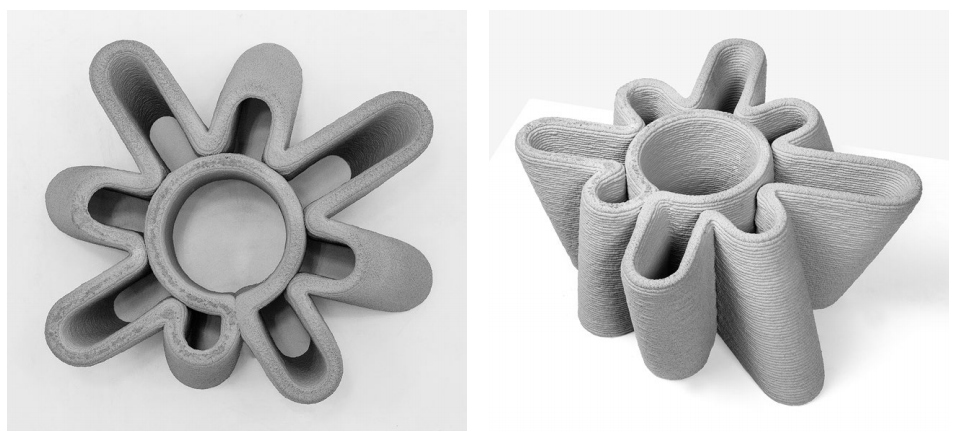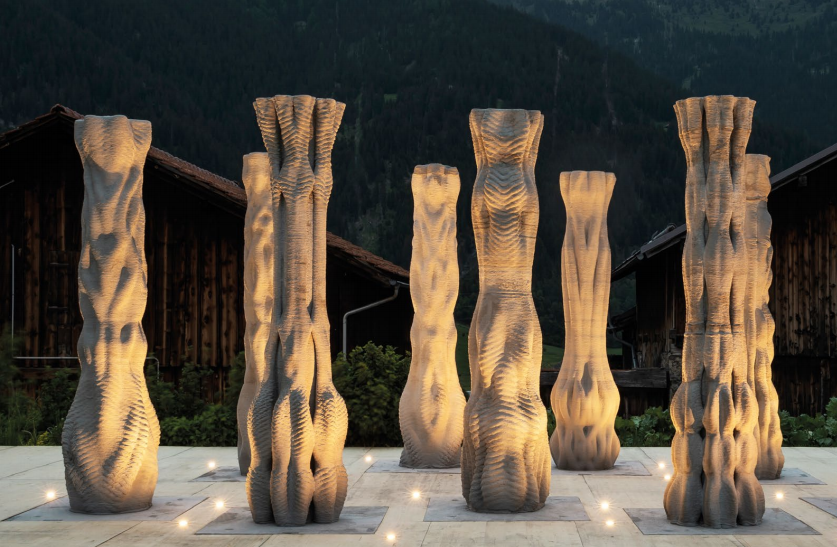International researchers continue to explore and refine 3D printing within architecture and progressive techniques regarding extrusion of cement, releasing their findings in the recently published ‘Concrete Choreography Prefabrication of 3D Printed Columns’ after an 18-month project.
The Concrete Choreography project is comprised of nine prefabricated concrete columns—meant to be a focal point of the Riom, Switzerland Origen Festival of Culture for the summer season—and centers around 3D concrete printing (3DCP). The project team integrated not only technology development but also computational design and robotics, meant to ‘reframe the challenge’ of digital fabrication on the large scale in high resolution.
With the project group exploring features for a new concrete typology, the columns represent the culmination of a studio course brief for the Master of Advanced Studies in Architecture and Digital Fabrication at ETH Zurich (ETHZ):
“Framing the latest research in 3DCP within the context of the performing arts, the project liberated design thinking from conventional concreting techniques and fostered a holistic approach to the conception and realization of a novel, multi-layered material system,” explained the researchers in their paper.
Along with construction of the columns, the group was on a mission to demonstrate the advantages offered to the architectural field via 3D printing, as well as showing ‘concrete’ evidence of one of the greatest benefits: the ability to create products or structures not previously possible with traditional methods. While recognizing the benefits of on-demand materially efficient printing, they also aimed to present:
- High production speed
- Fine print resolution
- Process stability
- Robust structure
“Another objective was to investigate the extrusion layer as a design instrument for high-resolution and multi-scalar material articulation. The column typology fulfilled the geometric criteria to test the fast, vertical build-up rate of the fabrication method, demonstrating the targeted qualities along significant element heights,” said the researchers.
More importantly—and touching on an issue most users have a vested interest in—the project team decided to take on the challenge of offering architectural innovation via 3D printing without any post processing. They also remained concerned about their ecological footprint while working; with 3D printing, however—and especially with materials like concrete—there is the opportunity to use less resources, along with minimizing the need for design space, and labor.
While the use of 3D printing in concrete has generated a flurry of industrial excitement regarding 3D printed homes—to include entire villages, low-cost housing, and offices, the project team’s mindset in this project was to continue encouraging freeform concepts and innovative ‘geometric exploration.’
“Although the many economic and environmental benefits of 3DCP inevitably lead to its quick adoption in industry, the process can achieve much more than simply inheriting the approaches and aesthetics of conventional concreting,” stated the project team members.
For this experiment, the mortar offered low-yield stress, along with limiting the overhang capacity, leaving very little opportunity for collapse in structures.

Overhang capacity: print tests show the maximum overhangs for good quality printing between [-20; 20] degrees Photo: Axel Crettenand.

Details: (a), (b), (d), (f) material ornament – print-path distortion using trigonometric functions; (b), (d) macro-porosity; (c) seam resulted from self-intersecting print-path; (a), (d), (f) gradual overhangs. Photo: Sofia Michopoulou.
“The shift in perception of concrete as an inert material and passive recipient of form – through formwork – towards directly organizing the material into the final artefact allows for an unprecedented geometric richness and material articulation,” said the project team.
“To conclude, the presented project not only proves transformative from an ecological and economical perspective but demonstrates that a design-oriented approach to concrete printing research can yield spectacular results that challenge building convention. This approach is necessary to realize the full architectural potential of 3DCP in its adoption to industry.”
What do you think of this news? Let us know your thoughts! Join the discussion of this and other 3D printing topics at 3DPrintBoard.com.
[Source / Images: ‘Concrete Choreography Prefabrication of 3D Printed Columns’]Subscribe to Our Email Newsletter
Stay up-to-date on all the latest news from the 3D printing industry and receive information and offers from third party vendors.
You May Also Like
World’s Largest Polymer 3D Printer Unveiled by UMaine: Houses, Tools, Boats to Come
The University of Maine has once again broken its own record by unveiling the largest polymer 3D printer in the world. Surpassing its 2019 achievement, the new Factory of the...
Changing the Landscape: 1Print Co-Founder Adam Friedman on His Unique Approach to 3D Printed Construction
Additive construction (AC) is much more versatile than it seems, at first: as natural as it is to focus on the exciting prospect of automated home construction, there’s far more...
Gorilla Sports GE’s First 3D Printed Titanium Cast
How do you help a gorilla with a broken arm? Sounds like the start of a bad joke a zookeeper might tell, but it’s an actual dilemma recently faced by...
3D Printing Webinar and Event Roundup: April 21, 2024
It’s another busy week of webinars and events, starting with Hannover Messe in Germany and continuing with Metalcasting Congress, Chinaplas, TechBlick’s Innovation Festival, and more. Stratasys continues its advanced training...































